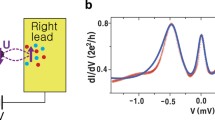Zusammenfassung
The contact between two superconductors, which we mentioned at the beginning of Chapter 6 in connection with Kamerlingh Onnes and Walther Meissner, was to take on a prominent role about three decades later. After Ivar Giaever had published the results of his famous tunnel experiment to prove the energy gap in superconductors, the student Brian David Josephson in Cambridge, England, became interested in the underlying tunneling process.
Access provided by Autonomous University of Puebla. Download chapter PDF
Similar content being viewed by others
The contact between two superconductors, which we mentioned at the beginning of Chapter 6 in connection with Kamerlingh Onnes and Walther Meissner, was to take on a prominent role about three decades later. After Ivar Giaever had published the results of his famous tunnel experiment to prove the energy gap in superconductors, the student Brian David Josephson in Cambridge, England, became interested in the underlying tunneling process. He had heard about the new BCS theory in lectures and was particularly impressed by the concept of superconductivity as a macroscopic quantum phenomenon. He theoretically investigated the flow of electric current through the barrier of a tunnel contact between two superconductors, as Giaever had also used it. He derived two equations for the electric current and for the electric voltage, which have since been known as Josephson equations:
In Eq. (7.1), the supercurrent flowing without electrical resistance is described by Cooper pairs. Equation (7.2) states that an electric voltage V at the tunnel contact is always accompanied by an alternating supercurrent oscillating at high frequency between the two superconductors. The frequency of this Josephson oscillation increases in proportion to the electrical voltage. Equations (7.1) and (7.2) are based on the concept that superconductivity is a macroscopic quantum phenomenon described by the wave function (order parameter) Eq. (5.1) with an amplitude \( \left| {\uppsi ({\mathbf{r}},{\text{ t}})} \right| \) and a phase φ(r, t). In Eq. (7.1), χ denotes the phase difference χ = φ2 − φ1 between both sides of the contact. The supercurrent Is flowing through the contact is given by the sine function of this phase difference χ = φ2 − φ1. IC denotes the critical current of this contact geometry.
The Josephson Eqs. (7.1) and (7.2) can be derived in different ways. A derivation by Richard Feynman starts with the time-dependent Schrödinger equation for the two wave functions ψ1 and ψ2 for the initially still separate superconductors 1 and 2 and adds a coupling between the two.
Josephson made his predictions in 1962 but his theory was initially met with skepticism and incomprehension. It was experimentally confirmed as early as 1963 (Fig. 7.1). The second Josephson equation again manifests the double elementary charge of the Cooper pairs responsible for superconductivity.
Josephson oscillation of the supercurrent between the superconducting electrodes of a tunnel contact in the presence of an electrical voltage at the contact. a In the Josephson contact, the two superconducting electrodes A and B are only weakly coupled to each other, for example, by a thin, electrically insulating barrier C, which still allows electrical current to flow through the quantum mechanical tunneling process. b The frequency ν of the Josephson oscillation of the supercurrent between the two electrodes increases proportionally to the electrical voltage V at the contact. At the voltage of 1 V, the frequency is approximately 483,000 GHz. c Electric current I as a function of the voltage V for a Josephson contact. The solid curve shows the tunnel current for superconductivity and the dashed straight line shows the tunnel current for normal conduction. At voltage zero, the Josephson pair current can be seen up to its maximum value I0. When the contact is irradiated with microwaves, the curve shows “Shapiro steps” caused by the interaction of the Josephson oscillation in the contact with the microwaves
Author information
Authors and Affiliations
Corresponding author
Rights and permissions
Copyright information
© 2021 Springer Fachmedien Wiesbaden GmbH, part of Springer Nature
About this chapter
Cite this chapter
Huebener, R.P. (2021). Josephson Effect. In: History and Theory of Superconductors. essentials(). Springer, Wiesbaden. https://doi.org/10.1007/978-3-658-32380-6_7
Download citation
DOI: https://doi.org/10.1007/978-3-658-32380-6_7
Published:
Publisher Name: Springer, Wiesbaden
Print ISBN: 978-3-658-32379-0
Online ISBN: 978-3-658-32380-6
eBook Packages: Physics and AstronomyPhysics and Astronomy (R0)




